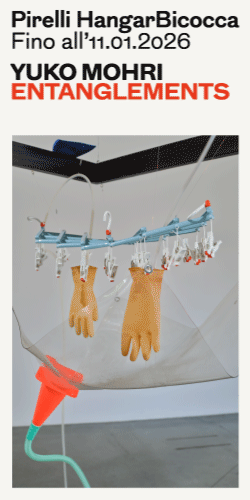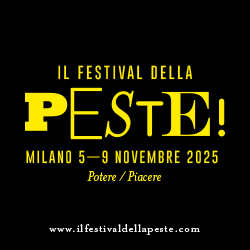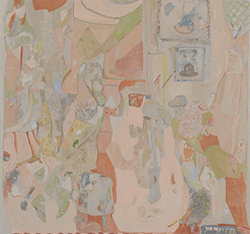
(Scroll down for the English version)
ATPdiary ha invitato i curatori delle mostre del progetto ONE Torino, a rispondere ad una serie di domande. Iniziamo con il curatore della mostra Repertory, Gary Carrion-Murayari (curatore al New Museum of Contemporary Art di New York) ospitata a Palazzo Cavour (Via Camillo Benso Conte di Cavour, 8 – Torino).
Il progetto espositivo si divide tra scultura, pittura, fotografia, film e installazioni di artisti storici, quali Ericka Beckmann, Heidi Bucher, David Haxton, Andreas Schulze e di artisti più giovani come Steven Claydon, Isabelle Cornaro, Elad Lassry, Christian Mayer, Arthur Ou, Karthik Pandian, Carmelle Safdie, Erin Shirreff, Sue Tompkins, Andra Ursuta e Andro Wekua.
ATP: Mi racconti brevementre il concetto della mostra?
Gary Carrion-Murayari: La mostra raccoglie una serie di opere che descrivono un approccio performativo degli oggetti – le diverse funzioni che possono svolgere come opere d’arte, le narrazioni possono produrre e mettere in atto, e il modo in cui gli oggetti possono trasportare e trasmettere la memoria all’interno delle loro superfici.
ATP: Dove è nata l’idea della mostra? Ha una relazione con la città di Torino?
G. C-M.: Ho ideato la mostra sia a New York, sia a Torino dopo aver visto lo spazio. La mostra non è strettamente legata in modo esplicito a Torino, ma ho sentito che era importante includere assieme sia dei giovani artisti, che figure storiche al fine di riconoscere a Torino il suo ruolo di città d’arte storica che riesce a dialogare in modo aperto con l’arte contemporanea.
ATP: Quali temi hai deciso di prendere in esame? Perché?
G. C-M.: In mostra è presentata una lunga serie di opere caratterizzate da una grande varietà di medium e provenienti da momenti storici differenti degli ultimi 40 anni. Ogni lavoro ha una qualità temporale distinta che utilizza il mezzo espressivo in un modo inaspettato. Mi sono interessato a quegli artisti che, in qualche modo, considerano il loro lavoro come un potenziale ‘attore’ in un senso narrativo e come strumento per condensare diversi tipi di storie e memorie.
ATP: C’è un’opera che, più di altre, sintetizza l’intera mostra? Perché?
G. C-M.: La mostra si è fortemente inspirata al film dell’artista britannico Ian Breakwell, chiamato Repertory (1973). Il film ritrae l’esterno di un teatro chiuso e descrive una serie di spettacoli che vi si svolgono all’interno. Le opere in mostra incarnano il diverso potenziale degli oggetti e delle superfici che il film descrive. Essi esistono come il loro repertorio.
ATP: La mostra è ospitata un luogo torinese importante. Quanto ha inciso la location sulla realizzazione della mostra?
G. C-M.: Palazzo Cavour è, ovviamente, uno spazio ricco di importanza storica con una forte memoria sia sociale che politica, ma a parte il nome e le tante targhe storiche presenti al suo esterno, la sua importanza non è necessariamente evidente dalla superficie della struttura stessa. Per molti versi, i ricordi della sua importanza storica e anche della vita e delle attività quotidiane che hanno avuto luogo, si sono integrate all’interno della sua superficie. Ciascuno a suo modo, le opere in mostra hanno impresso la memoria psicologica e diversi tipi di vite passate in questo luogo.
? Repertory / Palazzo Cavour / ONE TORINO

PALAZZO CAVOUR / Via Camillo Benso Conte di Cavour, 8 – Torino
REPERTORY
curated by Gary Carrion-Murayari, Curator, New Museum, New York
The project exhibits sculpture, paintings, photography, films and installations by such legendary artists as Ericka Beckmann, Heidi Bucher, David Haxton, Andreas Schulze and younger ones like Steven Claydon, Isabelle Cornaro, Elad Lassry, Christian Mayer, Arthur Ou, Karthik Pandian, Carmelle Safdie, Erin Shirreff, Sue Tompkins, Andra Ursuta and Andro Wekua.
ATP: Can you tell me a little bit more about the concept of the exhibition?
Gary Carrion-Murayari: The exhibition brings together a number of artworks that describe a performative approach to objects – the various functions they can fulfill as artworks, the narratives they can produce and enact, and the way in which objects can carry and transmit memory within their surfaces.
ATP: Where did you conceive the idea of the show? Does it have a connection with the city of Torino?
G. C-M.: I conceived the show both in New York and after visiting the space in Torino. The exhibition does not explicitly address Torino, but I felt that it was important to include both a mix of younger artists and more historical figures in order to acknowledge Torino’s important role as a historical art location and its continued importance within the dialogue of contemporary art.
ATP: Which topics have you decided to take into exam? And why?
G. C-M.: The exhibition features work in a variety of mediums and from different historical moments over the past 40 years. Each work has a distinct temporal quality that uses their medium in unexpected ways. I was interested in artist that consider their work somehow as a potential actor in a narrative sense and as a tool for accruing disparate kinds of histories and memories.
ATP: Is there an artwork that epitomize more than the others the whole show? Why?
G. C-M.: The exhibition was greatly inspired by a film by the British artist, Ian Breakwell, called Repertory (1973). The film captures the outside of a locked theater and describes a series of performances that would take place there. The works in the exhibition are their own kind of repertory performances – enacted not just by artists, but also by objects themselves.
ATP: The exhibition is hosted in a very important institution in Torino. How was the realization of the project influenced by the choice of the location?
G. C-M.: The Palazzo Cavour is obviously a space rich with historical significance with a social and political memory, which aside from its name and the historical plaques outside it, is not necessarily apparent from the surface of the structure itself. In many ways, the memories of its historical importance and also of the more quotidian lives and activities that have taken place there are embedded within its surface. Each in their own way, the works in the show are imprinted with psychological memory and different kinds of past lives.









